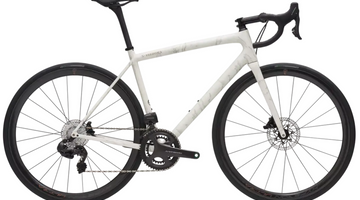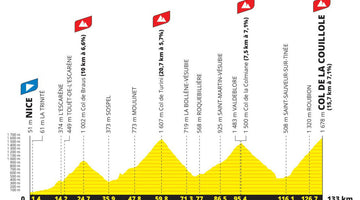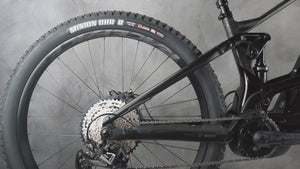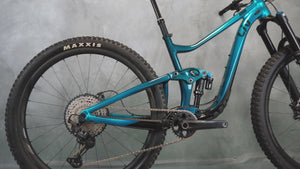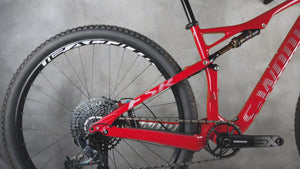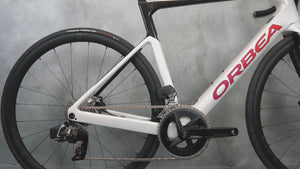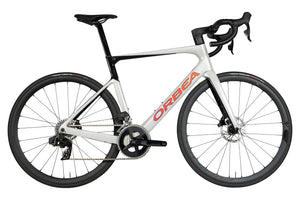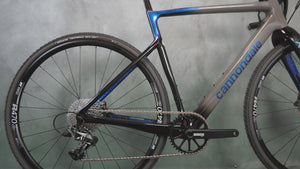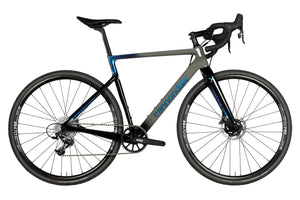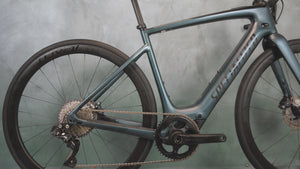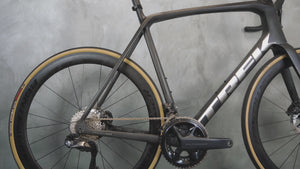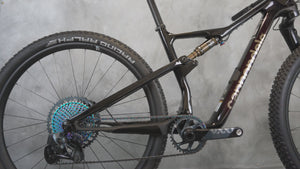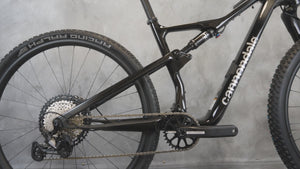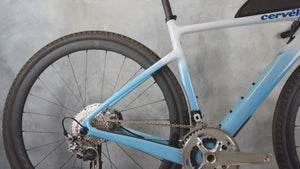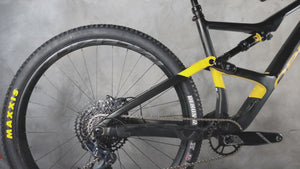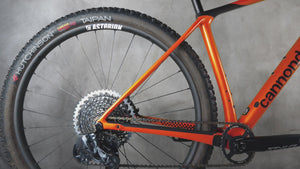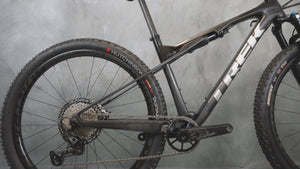Complete bottom bracket guide
In this Article
Published on 12 September 2024
If there is one area that has evolved significantly in cycling, it is the axles and bottom brackets. From a simple technology with a square axle, which is still common on entry-level bikes, it has significantly changed on high-end road bikes, particularly to increase performance and rigidity. Indeed, there are now several types of bottom bracket standards. What are their differences and how to know which bottom bracket matches a bike frame? The Cyclist House provides the answers. Specialising in the maintenance and sale of refurbished bikes and frames, the mechanics encounter virtually all types of bottom brackets. Here is a comprehensive guide to bottom brackets to understand all its nuances.

What is a bottom bracket?
The bottom bracket is one of the most essential parts of a bike. It is mounted in the lower part of the frame, connecting the cranks through a metal axle equipped with bearings. This axle allows for the transfer of power exerted on the pedals while reducing friction.
Different types of bottom brackets
There are several types of bottom brackets, each with its own dimensions and installation methods.
Hollow Axles
The Hollowtech Bottom Bracket
The Hollowtech bottom bracket, designed by Shimano, features a 24 mm hollow axle integrated with the right crank and external bearings. It aims to improve rigidity, reduce weight, and simplify installation. The left crank is attached via a splined interface, allowing for adjustment of play on that side. This bottom bracket is compatible with 68 and 73 mm frames using included spacers, offering versatility and performance for various types of bikes.
The SRAM GXP Bottom Bracket
The integrated axle bottom bracket with external bearings GXP was developed by SRAM/Truvativ. Like the Hollowtech, the crank axle is integrated with the right crank. The distinctive feature of the GXP standard is its asymmetrical axle: 24 mm on the right side and 22 mm on the left side, which improves fit and performance of cranks while reducing friction.
The SRAM DUB Bottom Bracket
This bottom bracket introduces a concept aimed at simplifying crank compatibility with most bike frames. The main goal is to create a single system with a 29 mm (28.99 mm precisely) crank axle that works with various bottom bracket standards, such as BSA, PF92, and BB30, thanks to a wide range of compatible bottom brackets. This allows for easier transfer of the crank from one frame to another without changing components.

Solid Axles
The Square Taper Bottom Bracket
The Square Taper bottom bracket, an older design, is still commonly found on entry-level bikes. It features a solid axle with a square profile and external bearings. While it provides adequate performance, its design is less rigid compared to modern standards and requires more maintenance.
The ISIS Bottom Bracket
The ISIS bottom bracket features a splined axle with a larger contact surface than the square taper, offering improved rigidity and reduced wear. Despite its advantages, it is less common today compared to newer standards.
Choosing the Right Bottom Bracket
Choosing the right bottom bracket depends on several factors, including the bike frame standard, crankset, and intended use. It is crucial to ensure compatibility between the frame and bottom bracket to guarantee optimal performance and longevity. A professional bike mechanic can assist in selecting the best bottom bracket for your specific needs.
This bottom bracket is an evolution of the traditional square taper. Thanks to a splined interface system, it offers better rigidity and performance in power transfer. There are two versions of the Octalink bottom bracket: one with 5 mm splines and the other with 9 mm splines, suited to different types of cranks to optimise efficiency and durability.
Types of Frame Mounting
Threaded Bottom Brackets
British Threaded Bottom Bracket
This is one of the most common types. The BSA standard has been around for over 100 years and is often referred to as the “English bottom bracket” or simply “threaded”. In recent years, many bike manufacturers have started adopting this standard again as it greatly simplifies the maintenance and replacement of bottom brackets, especially for amateur mechanics. It is installed by screwing the bottom bracket into the frame.
Italian and French Threaded Bottom Brackets
There are also bottom brackets with Italian threading (36 mm diameter), now very rare, as well as those with French or Swiss threading (35 mm diameter). Although these are no longer used today, they can still be found on some older bikes. These specific standards have become rare, replaced by more universal formats in most modern bikes.
Press-Fit Bearings Directly in the Frame
BB30
Mainly used for frames with wider tubes, it is inserted directly without the need for threading.
Created in 2009 by Cannondale, the BB30 was the first press-fit bottom bracket model to become popular in the industry. Its bearings are directly inserted into the frame, eliminating the need for threaded cups. This system offers several advantages: reduced gap between your crank arms, better efficiency due to stiffer 30 mm cranks, and simplified frame manufacturing. However, precise tolerance is crucial to avoid creaking, and maintenance requires specialised tools, such as a bearing press, making the process more complex for enthusiasts.
BB90
The BB90 is similar to the BB30 but is specifically designed for 24 mm cranks, such as Shimano Hollowtech II and SRAM GXP. Unlike the BB30, the BB90 does not use removable fixing clips, which simplifies its installation.
BBright
The BBright Press Fit is similar to the PF30 but features an asymmetrical design with a wider shell, allowing for larger and stiffer frame tubes. This standard is exclusive to Cervelo frames (and some older Factor models). BBright cranks are compatible with PF30 models and require an appropriate bottom bracket, but other options like Shimano Hollowtech II can also work with BBright bottom brackets as long as they are compatible.
Press Fit Mounting (with Plastic Cups)
BB86/92 & PF41
The BB86/92 is a press-fit standard designed for 24 mm cranks, such as Shimano Hollowtech II and SRAM GXP. The bearings are housed in plastic cups, which are then pressed into the frame. This design aims to better accommodate manufacturing tolerances and reduce the risk of creaking.
PressFit 30
Threaded bottom brackets, once dominant (e.g., Shimano Hollowtech II and SRAM GXP), have been replaced by 30 mm Pressfit systems, offering greater rigidity and reduced weight. Here, the bottom bracket is pressed directly into the frame, allowing for simpler and quicker installation.
The PF30 system is an evolution by SRAM using bearings placed in plastic cups that are then pressed into the frame. This provides better manufacturing tolerance and reduces creaking. However, each Pressfit standard requires specific tools and poses compatibility issues.
Although Pressfit is now common, it was initially used on high-end bikes, proving its advantages over time.
The BBright Direct Fit is a variant of BBright that uses BB30 bearings pressed directly into the frame, unlike the press-fit version. This version is less common and is mainly used on the Cervelo R5ca model.
BB386 EVO
An evolution of the system created by SRAM, the 386/392 EVO (also called BB386 or BB392) is similar to the PF30 but uses a wider bottom bracket shell. It requires a crank compatible with the 386/392 EVO standard for optimal fit and performance.
What do the numbers mean? The 3 represents 30 mm diameter and the 86 represents 86.5 mm bottom bracket axle length. Simple, right? 😉
As you’ve noticed, each of these names includes numbers. They correspond either to the crank diameter or the axle length, two factors to check for compatibility.
Can You Use Any Bottom Bracket on a Bike?
Indeed, this is the key question to ask before changing it. Each brand ensures that nothing is compatible. It would be far too easy otherwise 😀
The bottom bracket standards are numerous, each with its own specifics, which can make replacing the bottom bracket or bearings complex.
When changing a bottom bracket on your bike, there are 2 important points to check:
- The frame. It all starts with the brand and model of your bike frame. Generally, it is designed to accommodate a specific type of axle and bottom bracket.
- Type of bottom bracket. Do you have a threaded bottom bracket or a Press Fit, and if so, choose the correct diameter and length when changing it.
It is important to choose a bottom bracket that is compatible with both the crankset and the frame of your bike. Otherwise, it will simply be impossible to install.
How to Measure Your Bike's Bottom Bracket?
To choose the correct bottom bracket, you need to measure two elements:
- Bottom Bracket Length: it generally varies between 68 mm and 73 mm. Do not consider the cups.
- Internal Diameter of the frame where the bottom bracket will be installed, which depends on the standard used (e.g., 30 mm for BB30).

We hope this guide wasn’t too overwhelming. Rest assured, although the bottom bracket is crucial for your bike, it should not be a deciding factor when purchasing your bicycle. It is not a differentiating feature. However, the difference becomes noticeable during assembly. Press Fit requires a specific tool, unlike a threaded bottom bracket, so if you wish to maintain your bike yourself, it is ideally better to opt for the latter.

















